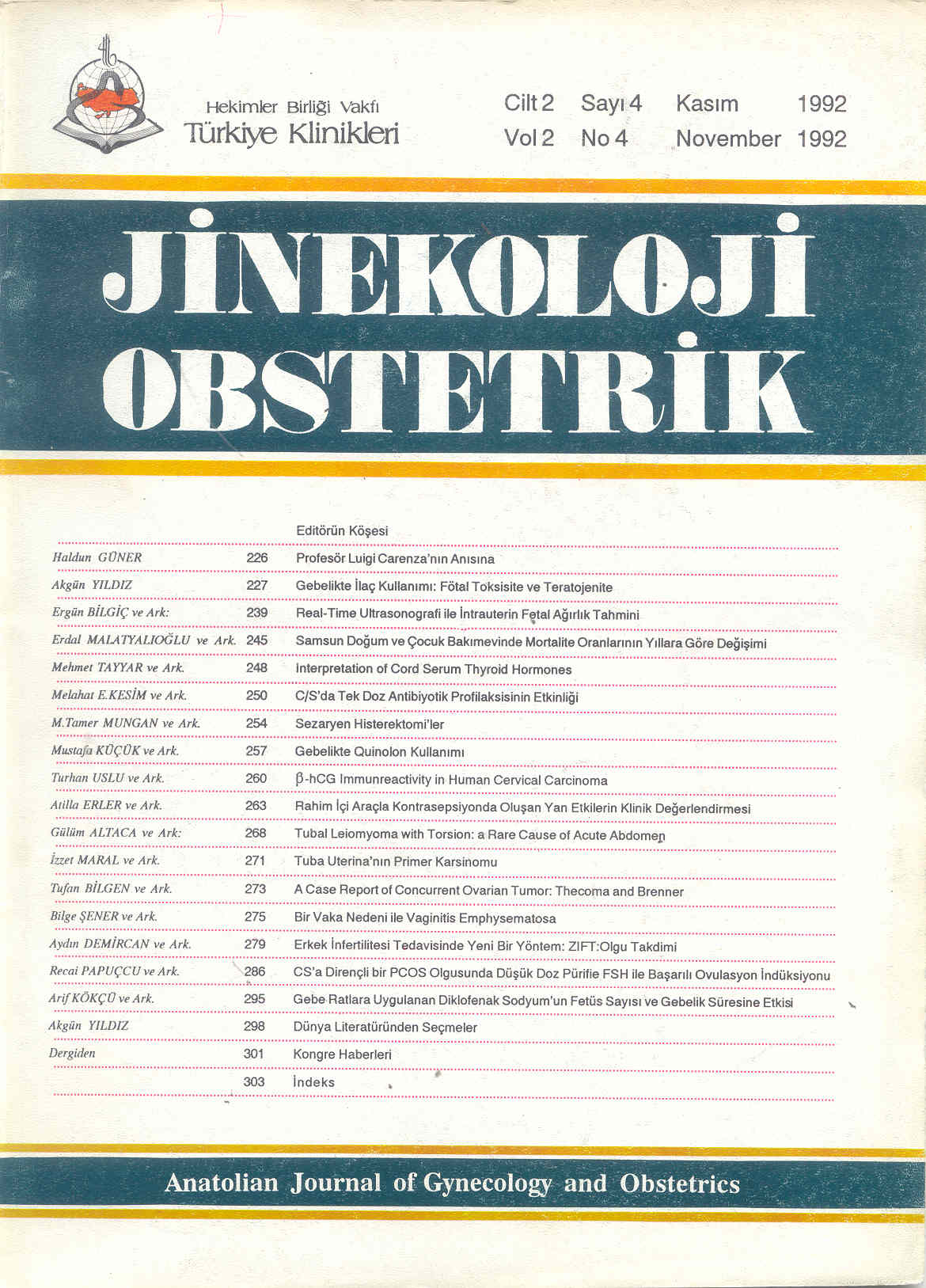Open Access
Peer Reviewed
ARTICLES
4213 Viewed1210 Downloaded
Clinical Evaluation Of Side Effects Of Contraception With Intrauterine Devıce
Rahim İçi Araçla Konstrasepsiyonda Oluşan Yan Etkilerin Klinik Değerlendirmesi
Turkiye Klinikleri J Gynecol Obst. 1992;2(4):263-7
Article Language: TR
Copyright Ⓒ 2025 by Türkiye Klinikleri. This is an open access article under the CC BY-NC-ND license (http://creativecommons.org/licenses/by-nc-nd/4.0/)
ÖZET
Bu çalışmada kontrasepsiyon amacıyla Copper-T-380A rahim içi araç (RIA) uygulanan 219 kadının 12 aylık takibi yapılmıştır. Menstrüel düzensizlik ve diğer nedenlerle RIA kullanımına son verilme oranları araştırılmıştır. RIA kullanımı sırasında menstrüel düzensizlik 47 (%21) olguda ortaya çıkmıştır. 3 olguda, bu yan etki nedeniyle RIA çıkarılırken, 44 olgu tıbbi tedavi ile düzelmiştir. RIA devamlılık oranı 1 yılın sonunda %93.6 olmuştur. Hasta yaşı, uterus büyüklük ve pozisyonunun menstrüel düzensizlik ile anlamlı bir ilişkisi bulunmamıştır. Daha önce RIA kullanmış kadınlarda, ilk defa kullananlara göre daha fazla yan etki gözlemlenmiştir. Pelvik iltihabi hastalık (PID) 2 kadında, ekspulsiyon 4 kadında RIA kullanımına son verirken, ekstrauterin gebelik saptanmamıştır. Düzenli klinik takibin RIA kullanım performansını arttırmada etkisi olduğu sonucuna varılmıştır.
Bu çalışmada kontrasepsiyon amacıyla Copper-T-380A rahim içi araç (RIA) uygulanan 219 kadının 12 aylık takibi yapılmıştır. Menstrüel düzensizlik ve diğer nedenlerle RIA kullanımına son verilme oranları araştırılmıştır. RIA kullanımı sırasında menstrüel düzensizlik 47 (%21) olguda ortaya çıkmıştır. 3 olguda, bu yan etki nedeniyle RIA çıkarılırken, 44 olgu tıbbi tedavi ile düzelmiştir. RIA devamlılık oranı 1 yılın sonunda %93.6 olmuştur. Hasta yaşı, uterus büyüklük ve pozisyonunun menstrüel düzensizlik ile anlamlı bir ilişkisi bulunmamıştır. Daha önce RIA kullanmış kadınlarda, ilk defa kullananlara göre daha fazla yan etki gözlemlenmiştir. Pelvik iltihabi hastalık (PID) 2 kadında, ekspulsiyon 4 kadında RIA kullanımına son verirken, ekstrauterin gebelik saptanmamıştır. Düzenli klinik takibin RIA kullanım performansını arttırmada etkisi olduğu sonucuna varılmıştır.
ANAHTAR KELİMELER: Kontrasepsiyon, rahim içi araç, menstrüel düzensizlik
ABSTRACT
In this study, 219 women were followed during 12 months period after applying of intrauterine device (IUD), copper-T 380A, as a contraceptive method. The effect of menstrual irregularities and other causes upon discontinuation rate of IUD were investigated in this time period. Menstrual disorders were observed in 47 (21%) of the women. This side effect caused IUD removal in 3 of these patients while 44 cases were improved by medical treatment. The continuation rate of IUD was 93.6% in the end of one year. Patient's age, uterine size and position had not significant correlation with menstrual disorders. It was observed more side effects in women who had story of previous IUD removal than the women who tried the method for the first time. Pelvic inflammatory disease, extrauterine pregnancy and expulsion caused IUD removal 2, none and 4 of the cases, respectively. As a result, we decided that close clinical follow-up of the IUD-bearing women caused to increase the contraceptive performance of this method.
In this study, 219 women were followed during 12 months period after applying of intrauterine device (IUD), copper-T 380A, as a contraceptive method. The effect of menstrual irregularities and other causes upon discontinuation rate of IUD were investigated in this time period. Menstrual disorders were observed in 47 (21%) of the women. This side effect caused IUD removal in 3 of these patients while 44 cases were improved by medical treatment. The continuation rate of IUD was 93.6% in the end of one year. Patient's age, uterine size and position had not significant correlation with menstrual disorders. It was observed more side effects in women who had story of previous IUD removal than the women who tried the method for the first time. Pelvic inflammatory disease, extrauterine pregnancy and expulsion caused IUD removal 2, none and 4 of the cases, respectively. As a result, we decided that close clinical follow-up of the IUD-bearing women caused to increase the contraceptive performance of this method.
MENU
POPULAR ARTICLES
MOST DOWNLOADED ARTICLES





This journal is licensed under a Creative Commons Attribution-NonCommercial-NoDerivatives 4.0 International License.










